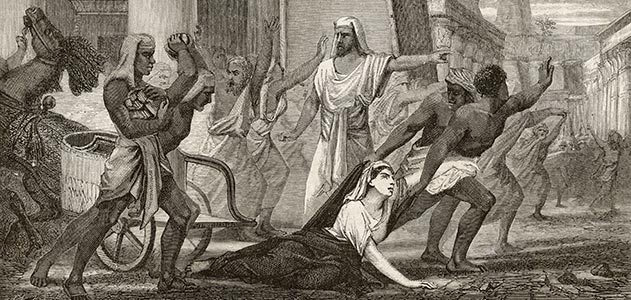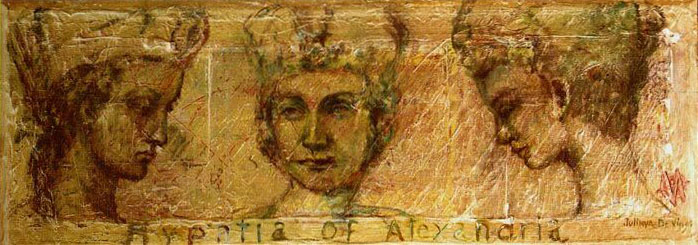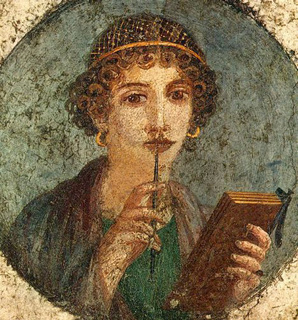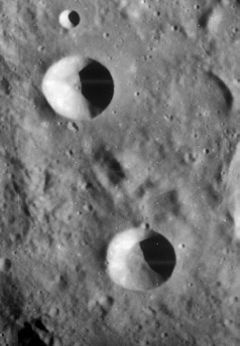
No true likeness remains of Hypatia. What we have is imagined. The most famous “portrait” is in the work of Raphael: his astonishing ‘The School of Athens.’ Painted on a wall in the Vatican a thousand years after her lifetime, Hypatia is the only woman represented in a gathering of the West’s greatest ancient philosophers and scholars. Draped in pure white, she stares out at us over the centuries: young, beautiful, alone. Perhaps Raphael saw Hypatia as curious about us as we are about her. But to paint her looking directly out of his picture, he betrays his own intense interest. Or perhaps he was trying to tell us something? If so, whatever that is remains with Raphael…and with speculation. (Source: Flow Down Like Silver: Hypatia of Alexandrea (http://www.flowdownlikesilver.com/historical.html)
Synesius of Cyrene (c.370-c.413) was a Neo-Platonic philosopher who became bishop of Ptolemais in the Cyrenaica. He left behind a small corpus of texts that offer much information about daily life in Late Antiquity, and about the Christianization of the Roman world. As Hypatia’s most devoted student, Synesius was also poet-mathematician-astroner-philospher’s most diligent correspondent. Those letters remain the only first hand information remaining about Hypatia. In them we see a Bishop of the Christian Church besotted with a Hellenistic mind, perhaps even a Hellenistic body. His need for her attention and respect overflows his pages. His complaints (you don’t answer, you leave me alone, bereft, lost without the sound of your exalted voice or the sight of your exalted words) tells us that her time was filled with teaching and studying and the constant visits of important men whose first task upon reaching Alexandria was an audience with Hypatia. It also seems to say that Synesius asked for far too much. Without her letters to Synesius (or, for that matter, to or from anyone else: more interesting “disappearances” since she was said by Synesius to have been a copious letter writer), all is guesswork. The texts of the letters below are improved versions of translations by A. Fitzgerald. The first letter, written in 402, contains the first written description of a densimeter. (Fitzgerald calls it a hydrometer.)
To the Philosopher [Hypatia]
I am in such evil fortune that I need a hydroscope. See that one is cast in brass for me and put together.
The instrument in question is a cylindrical tube, which has the shape of a flute and is about the same size. It has notches in a perpendicular line, by means of which we are able to test the weight of the waters. A cone forms a lid at one of the extremities, closely fitted to the tube. The cone and the tube have one base only. This is called the baryllium. Whenever you place the tube in a liquid, it remains erect. You can then count the notches at your ease, and in this way ascertain the specific gravity of the water.
Note
The instrument is probably a densimeter, used to measure the density of liquids. Synesius’ description is pretty accurate
The cylindrical tube and the shape of a tube are clearly recognizable. It’s also correct that it has about the same size of a flute. The densimeter remains erect in a liquid as it’s made heavier at its bottom. I suppose Synesius’ densimeter was made of wood with a piece of metal attached to its bottom. The way a densimeter works is based on Archimedes’ famous principle, described in On floating bodies:
Any object, wholly or partially immersed in a fluid, is buoyed up by a force equal to the weight of the fluid displaced by the object.
Obviously a densimeter has to float in the liquids we want to research. That means that the average density of the densimeter has to be smaller than the density of the liquid. This makes it likely that Synesius’ densimeter was made of wood indeed. Wood has a relatively small density and thus will not sink easily.
Now it’s impossible to measure forces and densities directly. What the densimeter really measures is the volume (or rather the depth) of the densimeter underneath the surface of the liquid. The weight of the instrument being equal to that buoyant force (as it lies stable in the liquid) that volume is inverse proportional to the density of the liquid: if the latter is doubled the volume underneath the surface will be halved. The perpendicular notches Synesius writes about obviously refer to the scale division, which is not linear.
The craftsman who designed Synesius’ densimeter obviously must have understood the concept of specific gravity and/or density. What’s more, he must have known and understood Archimedes’ hydrostatics plus likely the mathematical concept of inverse proportionality – or he simply could not have handmade the instrument.
Obviously we cannot determine how accurate the instrument was, but Synesius seemed to be satisfied in this respect. That allows us to speculate that quite some knowledge and understanding of physics and maths had been preserved as late as 400 CE, which is almost seven centuries after Archimedes did his research. If this is correct we cannot maintain that the scientific level declined during the Roman Empire. Before I read this letter I assumed that Augustine of Hippo with his excellent reflections on time in Confessions (at the end of the fourth century) was exceptional, but that is not the case as this letter shows.
Mark Nieuweboer, Teacher Physics and math, Moengo, Suriname
Losing contact with the outer world
This letter was written in 413, when Synesius was experiencing great problems being in conflict with the governor Andronicus. This, his penultimate letter to Hypatia, reveals what many scholars believe is the married bishop’s unrequited love for her.
To the Philosopher [Hypatia]
I salute you, and I beg of you to salute your most happy comrades for me, august Mistress. I have long been reproaching you that I am not deemed worthy of a letter, but now I know that I am despised by all of you for no wrongdoing on my part, but because I am unfortunate in many things, in as many as a man can be.
If I could only have had letters from you and learnt how you were all faring–I am sure you are happy and enjoying good fortune–I should have been relieved, in that case, of half of my own trouble, in rejoicing at your happiness. But now your silence has been added to the sum of my sorrows
I have lost my children, my friends, and the goodwill of everyone. The greatest loss of all, however, is the absence of your divine spirit. I had hoped that this would always remain to me, to conquer both the caprices of fortune and the evil turns of fate.
Hypatia of Alexandria, the Last Philosopher of the Hellenistic Era and Her Brutal Assassination
Hypatia: A Brief History

On the streets of Alexandria, Egypt, a mob led by Peter the Lector brutally murdered Hypatia, one of the last great thinkers of ancient Alexandria. (Mary Evans Picture Library/Alamy)
Neo-platonism is a progressive philosophy, and does not expect to state final conditions to men whose minds are finite. Life is an unfoldment, and the further we travel the more truth we can comprehend. To understand the things that are at our door is the best preparation for understanding those that lie beyond. –Hypatia
Hypatia was a mathematician, astronomer, teacher, editor, inventor, musician and author. In March, 415 A.D. she was murdered by a mob of fanatics on the steps of a church called The Caesarium in Alexandria, Egypt. She has become a symbol of martryed Reason, feminism and Classical paganism.
Though her exact birth year is unknown, most scholars have agreed on 350 AD. The Polish historian Maria Dzielska, arguing that the career path of a 4th century academic might parallel a modern one, suggests that Hypatia was born around 355, which would have made her 60 when she died. This chronology allows her to be significantly older than her more notable students, conforming to modern convention. One should bear in mind, though, that a Roman girl was a legal adult at the age of 12, and in an age when life was nasty, brutish and short, people did not have the luxury of prolonging childhood, adolescence and graduate school into their thirties.
She edited a number of works in collaboration with her father, the mathematician Theon, last director of the Museion that was the center of scholarship in the classical world. Among them were a commentary on the 13-volume Arithmetica by Diophantus, which plays a role in the novel. She also edited Theon’s commentary on Euclid’s Elements, which was likely the basis for every geometry text for the next fifteen centuries.
She probably wrote The Astronomical Canon, which was part of Theon’s commentary on Ptolemy’s Almagest: the book that defined the Western view of the universe until Galileo’s discoveries in 1610. Although Ptolemy’s geocentric theory was incorrect, his Almagest remains a model of rigorous mathematical exposition and in a roundabout way it led to the discovery of the Americas; Ptolemy was also a geographer, and he erroneously placed India far enough east to make Columbus’s plan seem plausible. The compilation of Ptolemy’s work that survived to let him be considered the ultimate authority at the beginning of the Renaissance likely derived from the edition prepared by Theon and Hypatia.
Our only first-hand source materials are the letters written to Hypatia by her student, Bishop Synesius of Cyrene, who addresses her as “mother and sister,” suggesting not only his great respect but caution appropriate to a married cleric (he was granted a dispensation to retain his wife when he assumed the bishopric). He clearly adored Hypatia and took pains to keep his letters on a lofty plane, lest she be irritated by his attention. Like many geniuses, Hypatia was likely a prickly personality, as evidenced by the only anecdote that offers an insight into her personal life, which has her hurling her menstrual rags at a lovesick student. One of Synesius’s letters asks plaintively why she has not responded to his last letter. Despite his best efforts to remain scholarly the letter has a tone suggestive of unrequited love.
One day on the streets of Alexandria, Egypt, in the year 415 or 416, a mob of Christian zealots led by Peter the Lector accosted a woman’s carriage and dragged her from it and into a church, where they stripped her and beat her to death with roofing tiles. They then tore her body apart and burned it. Who was this woman and what was her crime? Hypatia was one of the last great thinkers of ancient Alexandria and one of the first women to study and teach mathematics, astronomy and philosophy. Though she is remembered more for her violent death, her dramatic life is a fascinating lens through which we may view the plight of science in an era of religious and sectarian conflict.
Contrasting views of Hypatia’s life and death
Socrates Scholasticus (writing in AD 450): “There was a woman at Alexandria named Hypatia, daughter of the philosopher Theon, who made such attainments in literature and science, as to far surpass all the philosophers of her own time. Having succeeded to the school of Plato and Plotinus, she explained the principles of philosophy to her auditors, many of whom came from a distance to receive her instructions. On account of the self-possession and ease of manner, which she had acquired in consequence of the cultivation of her mind, she not infrequently appeared in public in presence of the magistrates. Neither did she feel abashed in coming to an assembly of men. For all men on account of her extraordinary dignity and virtue admired her the more. Yet even she fell a victim to the political jealousy which at that time prevailed. For as she had frequent interviews with Orestes, it was calumniously reported among the Christian populace, that it was she who prevented Orestes from being reconciled to the bishop. Some of them therefore, hurried away by a fierce and bigoted zeal, whose ringleader was a reader named Peter, waylaid her returning home, and dragging her from her carriage, they took her to the church called Caesareum, where they completely stripped her, and then murdered her with tiles [oyster shells]. After tearing her body in pieces, they took her mangled limbs to a place called Cinaron, and there burnt them. This affair brought not the least opprobrium, not only upon Cyril, but also upon the whole Alexandrian church. And surely nothing can be farther from the spirit of Christianity than the allowance of massacres, fights, and transactions of that sort. This happened in the month of March during Lent, in the fourth year of Cyril’s episcopate, under the tenth consulate of Honorius, and the sixth of Theodosius [AD 415].” —Ecclesiastical History (VII.15)
John, Coptic Bishop of Nikiu: “And in those days there appeared in Alexandria a female philosopher, a pagan named Hypatia, and she was devoted at all times to magic, astrolabes and instruments of music, and she beguiled many people through Satanic wiles. And the governor of the city [Orestes] honoured her exceedingly; for she had beguiled him through her magic. And he ceased attending church as had been his custom….And he not only did this, but he drew many believers to her, and he himself received the unbelievers at his house….And thereafter a multitude of believers in God arose under the guidance of Peter the magistrate—now this Peter was a perfect believer in all respects in Jesus Christ—and they proceeded to seek for the pagan woman who had beguiled the people of the city and the prefect through her enchantments. And when they learnt the place where she was, they proceeded to her and found her seated on a (lofty) chair; and having made her descend they dragged her along till they brought her to the great church, named Caesarion. Now this was in the days of the fast. And they tare off her clothing and dragged her through the streets of the city till she died. And they carried her to a place named Cinaron, and they burned her body with fire. And all the people surrounded the patriarch Cyril and named him ‘the new Theophilus’; for he had destroyed the last remains of idolatry in the city.” –The Chronicle (LXXXIV.87-88, 100-103)
And this account of her response to an overeager suitor:
Damascius: “In addition to her expertise in teaching she rose to the pinnacle of civic virtue. She was both just and chaste and remained always a virgin. She was so beautiful and shapely that one of her students fell in love with her and was unable to control himself and openly showed her a sign of his infatuation. Uninformed reports had Hypatia curing him of his affliction with the help of music. The truth of this story is that she demonstrated the not-so-lovely side of being a woman, to teach him about the folly of his infatuation, and he had a change of heart and went away a better man.”
Sources: “Hypatia, Ancient Alexandra’s Great Female Scholar,” by Sarah Zielinski, Smithsonian Magazine, March 15, 2010
“Hypatia–Philosopher’s Daughter,” posted February 24, 2013 at egyptexperience
Hypatia Lives…On the Moon
Hypatia lives on forever, sitting serenely on the Moon by the shores of Sinus Asperitatis, located between Mare Tranquillitatis and Mare Nectaris.
Two features are named for Hypatia, an irregular crater and a system of rilles. The crater is medium sized, measuring 41km x 28km, and is located 4.3°S and 22.6°E of the meridian. Rimae Hypatia is located north of the crater, just one degree south of the equater, and is 180km long.
The crater named for Hypatia’s father, Theon of Alexandria (who edited Euclid’s Elements and wrote commentaries on works by Euclid and Ptolemy), is located northwest of the Hypatian features at 2.3°S, 15.8°E. It is a circular crater and prominent at 18.6km in diameter and 3,580 meters deep, from rim to bottom
The area where the Hypatian features are located is within 100km south of the Apollo 11 landing site. Best seen a couple of days before the first quarter or a couple of days after the last quarter Moon, the features are visible in a small telescope.
(Above) Lunar Orbiter 4 image of Theon Senior (top) and Theon Junior (bottom). Theon Junior is a lunar impact crater that is located just to the west-southwest of the crater Delambre. It forms a matching pair with Theon Senior, only a couple of crater diameters to the north-northwest. The crater is circular and bowl-shaped, with a small floor at the bottom of the high, sloping interior walls. It is named for Theon of Alexandria, a 4th-century Greek astronomer and mathematician better known today as Hypatia’s father. The crater is from the Eratosthenian period, which lasted from 3.2 to 1.1 billion years ago. It is 17 kilometers in diameter and the difference in height at its rim and its deepest part is 3,580 meters.
Above: The lunar crater Hypatia lies along the northwest edge of Sinus Asperitatis, a bay on the southwest edge of Mare Tranquillitatis. The nearest crater with an eponym is Alfraganus to the west-southwest. However, farther to the south-southeast, across the lunar mare, is the prominent crater Theophilus. Hypatia is an asymmetrical formation with a rugged, irregular outer rim that is cut through by narrow clefts in several locations. It is generally longer along an axis running to the north-northwest, with the widest outward bulge occurring on the west side at the northern end. It resembles a merger of several crater formations that have gained a common interior floor. Attached to the exterior rim along the southwest is the satellite crater Hypatia A, a more symmetrical, bowl-shaped crater.About 70 kilometers to the north of Hypatia is a system of linear rilles designated Rimae Hypatia. This runs for a length of about 180 kilometers across the Mare Tranquillitatis, and generally follows a course to the south-southeast. Rimae Hypatia is shown in the background of this photo.








